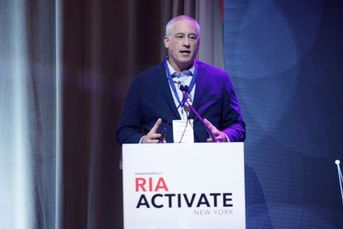Market pain boosts case for adding alternatives to retirement accounts

An increasing number of wealth managers are diversifying their clients’ portfolios away from traditional asset classes into alternative, and often less liquid, assets.
The volatile stock market and rising inflation have investors who are in or near retirement literally looking for alternatives.
A Mercer survey released last week found that inflation is the biggest concern for wealth managers globally, with nearly half of respondents expecting investment returns to be lower in the coming two years than what they’ve experienced in recent years. As a result, the report shows an increasing number of wealth managers diversifying their clients’ portfolios away from traditional asset classes — aka good old stocks and bonds, generally in a 60/40 split — into alternative, and often less liquid, assets.
According to the Mercer report, 73% of wealth managers are either invested in or considering investing in illiquid assets in the next 12 months, with an overwhelming majority (86%) saying the main reason for investing in private markets and other illiquid asset classes is for “better yields or enhanced investment returns.”
“It is encouraging to see the majority of wealth managers embracing and investing in illiquid and other alternative asset classes, citing yield and return potential. With traditional asset classes unlikely to generate the same level of returns in the next few years as they did in the past, it is critical that wealth managers’ client portfolios are positioned to seize the widest range of investment opportunities,” Gregg Sommer, partner and US financial intermediaries leader at Mercer, said in a statement.
In other words, when the S&P 500 is down 25% year-to-date, and the iShares Core U.S. Aggregate Bond ETF (AGG) is down 14% over the same period, financial advisers are seeking any port to help their clients weather the storm. And that goes double for their retired clients.
Steven Brod, CEO and chief investment officer at Crystal Capital Partners, for one, is not surprised by the Mercer results — not only because of the turbulence the market is currently experiencing, but also because of the value alternatives have historically offered to portfolios.
“Using the Ivy League endowments as an example, many have reported a substantial allocation to alternatives in their filings, some upwards of 60%. In a variety of market conditions, their alternatives portfolios have shown tremendous flexibility in generating value,” Brod said. “Building on this ‘endowment model,’ we are firm believers that alts have the potential to offer a wider audience of investors better risk-adjusted, low-correlated returns.”
Despite their longstanding success in endowments and pension portfolios, alternatives have yet to penetrate the defined-contribution market. Given the current market environment, however, the return profiles and unique diversification of illiquid alternatives may mean that alternative investments are coming soon to a 401(k) near you.
According to a Cerulli report released last week, DC institutional consultants report that less than 1% of DC plans offer their participants private credit, private equity and hedge funds. Private real estate is the only outlier, with 10% of plans that are intermediated by an institutional investment consultant containing private real estate, the study showed.
“As the U.S. experiences high inflation, there is a compelling case to be made for private real estate in DC plans, particularly for older participants without the longer time horizon and high public equity exposures of their younger counterparts,” Cerulli analyst David Swart noted in a statement.
Meanwhile, the Cerulli study showed only 4% of target-date funds, the core of most 401(k) plans, allocate to private equity and private debt, and none allocate to hedge funds within their off-the-shelf target-date series.
Swart, for one, believes further investment in alternatives, particularly within pooled vehicles such as TDFs, may help retirement investors achieve superior risk-adjusted returns and diversification benefits.
“While retirement investors should focus mostly on the long-term horizon, diversification across asset classes, including alternatives, can prove beneficial to achieving a balance and consistent return capable of sustaining income and quality of life in retirement,” he said.
BETTER HALT THOSE ALTS
Of course, introducing new private, and often illiquid, assets to investors is never easy, even in the best market environments. And it’s certainly not so when dealing with highly regulated DC plans that tend to lean heavily on low-fee TDFs.
The authors of the Cerulli study, for example, said they expect conversations surrounding the inclusion of private equity in DC plans to be relegated mostly to large and mega plans and the consultants that work with them. The Mercer survey found 71% of wealth managers were concerned with lock-up periods, while 59% said they did not have the necessary resources to perform the required due diligence before investing.
Moreover, 21% of wealth managers surveyed by Mercer said their clients thought fees were too high for these types of investment funds and strategies.
Ron Surz, CEO of Target Date Solutions, agrees with them.
“I don’t think alternatives are a good fit for TDFs because they are expensive and the pressure is on low fees because lawsuits are being won for excessive fees,” Surz said. “Adding enough alternatives to move the needle would place a TDF at a disadvantage due to noncompetitive fees.”
Clive Slovin, president and CEO of the Strategic Financial Alliance, said it’s hardly surprising that more advisers are showing a renewed interest in alternatives considering the recent performance of the equity and fixed-income markets. Furthermore, he thinks it’s an overall positive step for such non-correlated assets to become more widely available, as it offers wealth managers increased options to serve clients.
Still, Slovin said such specialized products remain appropriate only for a small slice of mass affluent investors.
“Many of the alternatives that have often performed better are focused on energy and real estate, and projects in these industries have long time horizons for a reason — it can take years for some of them to come full cycle — so these are not solutions for anyone searching for yield in the short term,” he said.
Along similar lines, Howard Coleman, chief investment officer at Coldstream Wealth Management, lauds the improvement and expansion of private market products now available to RIAs, pointing out that “years like this show the worth of investing in that space.” Nevertheless, he remains concerned that some RIAs may be jumping in without sufficient experience with private markets.
“I question whether they have the background necessary to analyze the risks of a particular strategy or fund. Make no mistake, doing due diligence on private funds requires far more expertise than publicly traded mutual funds and ETFs,” Coleman said.
‘IN the Office’ with Michael Natale, head of intermediary distribution at Northern Trust
Learn more about reprints and licensing for this article.








